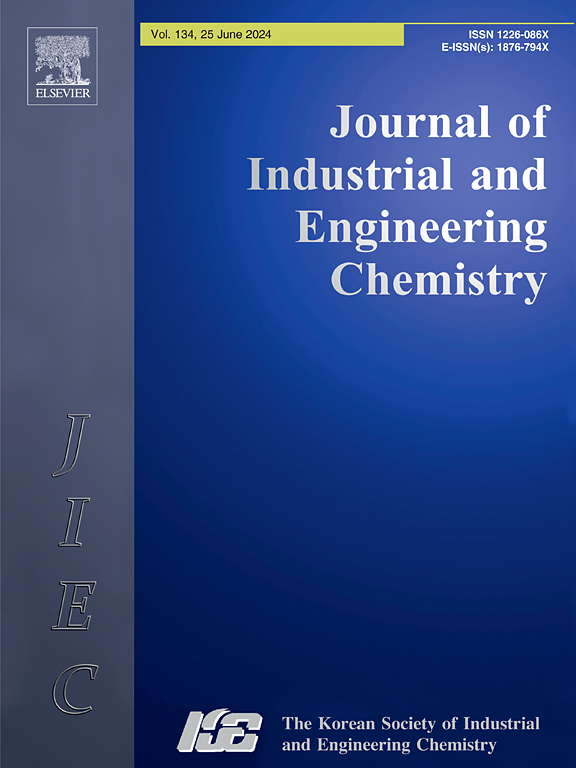Bi-doped g-C3N4/Bi2WO6 ternary composites for superior photocatalytic degradation of reactive orange 16 under visible light irradiation
IF 5.9
3区 工程技术
Q1 CHEMISTRY, MULTIDISCIPLINARY
Journal of Industrial and Engineering Chemistry
Pub Date : 2025-01-25
DOI:10.1016/j.jiec.2024.07.007
引用次数: 0
Abstract
Because of unrestricted disposal, the concentration of reactive dyes in wastewater is gradually increasing. Owing to their eco-toxicity their removal becomes so crucial. In this regard, Bi(0)-doped g-C3N4/Bi2WO6 (g-C3N4/Bi@Bi2WO6) nanocomposites were prepared by wet impregnation followed by calcination. Remarkably, the Bi(0) doping occurs concertedly during the preparation of Bi2WO6 without the addition of any extra reducing agent. The efficacy of the photocatalyst for eliminating reactive orange 16 was evaluated under visible light irradiation. XRD, FESEM, HRTEM, DRS, XPS, BET, etc., were employed to characterize these hybrids. The presence of Bi(0) was confirmed by HRTEM and XPS. Increasing the g-C3N4 content enhances the specific surface and reduces the charge transfer resistance. Among the various photocatalysts, the 20 wt% g-C3N4/Bi@Bi2WO6 hybrid owned the highest degradation efficiency of 89 % after 300 min of reaction time. The controlled experiments confirm the participation of holes and superoxide anions during the reactions. The various reaction intermediates were detected by HRMS providing the necessary evidence about the mechanism. The heterostructure possesses excellent reusability and stability. Due to enhanced catalytic activity, high stability, and ease of synthesis, the reported composite can be considered as a promising catalyst for the degradation of pollutants.

双掺杂 g-C3N4/Bi2WO6 三元复合材料在可见光照射下对活性橙 16 的光催化降解效果更佳
由于不受限制的处理,废水中活性染料的浓度逐渐升高。由于它们的生态毒性,清除它们变得至关重要。为此,采用湿浸渍-煅烧法制备了Bi(0)掺杂g-C3N4/Bi2WO6 (g-C3N4/Bi@Bi2WO6)纳米复合材料。值得注意的是,在制备Bi2WO6的过程中,没有添加任何额外的还原剂,Bi(0)掺杂是一致发生的。在可见光照射下评价了光催化剂去除活性橙16的效果。采用XRD、FESEM、HRTEM、DRS、XPS、BET等对这些杂化物进行了表征。通过HRTEM和XPS证实了Bi(0)的存在。g-C3N4含量的增加提高了比表面,降低了电荷传递电阻。在各种光催化剂中,20 wt%的g-C3N4/Bi@Bi2WO6复合催化剂在反应300 min后的降解效率最高,达到89%。对照实验证实了空穴和超氧阴离子参与了反应。HRMS检测了各种反应中间体,为反应机理提供了必要的证据。该异质结构具有良好的可重用性和稳定性。由于催化活性增强,稳定性高,易于合成,因此该复合材料可以被认为是一种很有前途的污染物降解催化剂。
本文章由计算机程序翻译,如有差异,请以英文原文为准。
求助全文
约1分钟内获得全文
求助全文
来源期刊
CiteScore
10.40
自引率
6.60%
发文量
639
审稿时长
29 days
期刊介绍:
Journal of Industrial and Engineering Chemistry is published monthly in English by the Korean Society of Industrial and Engineering Chemistry. JIEC brings together multidisciplinary interests in one journal and is to disseminate information on all aspects of research and development in industrial and engineering chemistry. Contributions in the form of research articles, short communications, notes and reviews are considered for publication. The editors welcome original contributions that have not been and are not to be published elsewhere. Instruction to authors and a manuscript submissions form are printed at the end of each issue. Bulk reprints of individual articles can be ordered. This publication is partially supported by Korea Research Foundation and the Korean Federation of Science and Technology Societies.

 求助内容:
求助内容: 应助结果提醒方式:
应助结果提醒方式:


